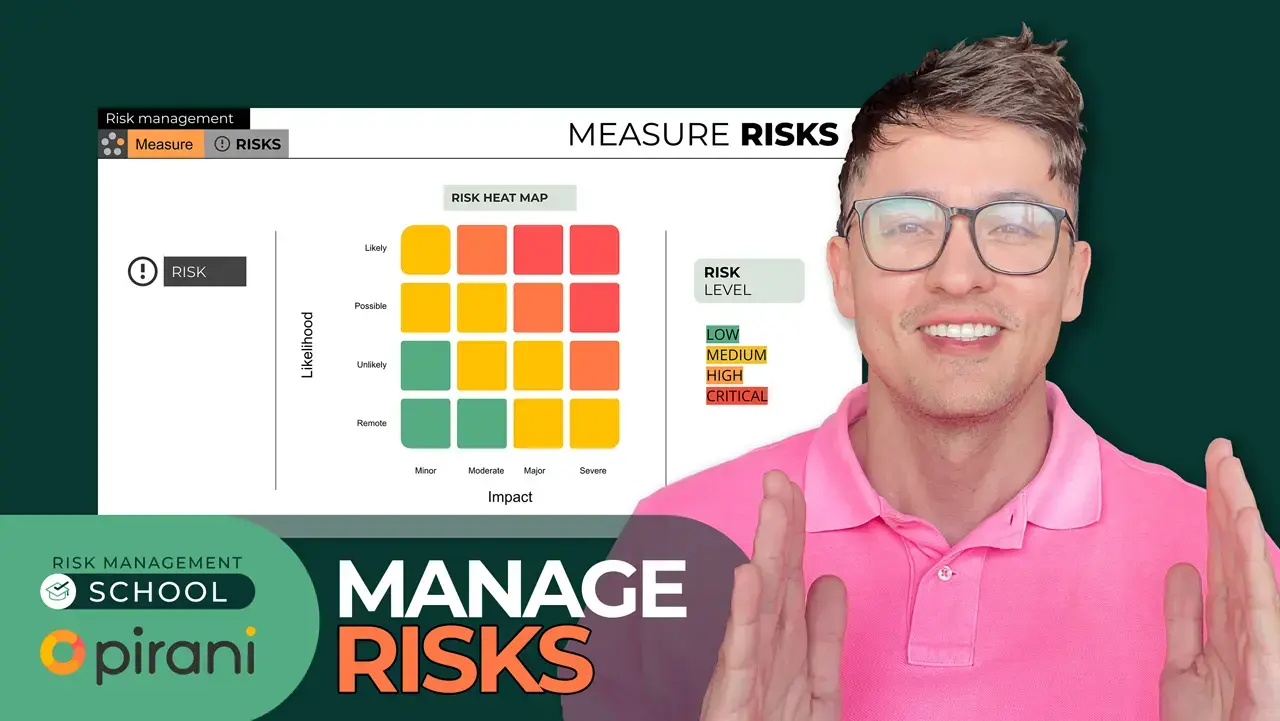Risk Assessment Matrix
by Risk Management School on 2 de September de 2024
In this class, Alejandro Orrego, CEO at Pirani, teaches us about key components of a Risk Assessment Matrix, impact variables, measure risks, and risk management strategies.
Risk Assessment Matrix 
A Risk Assessment Matrix is a tool used in risk management to evaluate and prioritize potential risks by categorizing them based on their likelihood and impact.
It provides a visual representation that helps in assessing the severity of risks and deciding which ones need attention.
Key Components of a Risk Assessment Matrix
IMPACT: Impact refers to the potential consequences or effects of a risk event on an organization's objectives. The impact can be positive (an opportunity) or negative (a threat) and can affect various aspects of the organization, such as financial performance, reputation, safety, or environmental factors.
LIKELIHOOD: Likelihood refers to the probability or chance of a risk event occurring. It is a measure of the frequency or occurrence of the risk and can be expressed qualitatively (e.g., low, medium, high) or quantitatively (e.g., a percentage or frequency rate).
This How It Works:
- The matrix is a grid with Likelihood on one axis and Impact on the other.
- Risks are plotted on the grid based on their assessed likelihood and impact.
- Common matrix formats are 3x3, 4x4, or 5x5 grids, depending on the granularity needed.
The Purpose:
- Prioritize risks to focus resources on high-risk areas.
- Assist in decision-making regarding which risks to mitigate, transfer, avoid, or accept.
- Low Risk:
Manage with routine procedures. - Medium/High Risk:
Requires monitoring and some control measures. - Critical/Severe Risk:
Needs immediate and active mitigation efforts.
Impact variables
- Operational
The impact of a risk can also affect a company's operational efficiency, such as through supply chain disruptions, equipment failures, or cyber-attacks. This can result in lost productivity, delays in delivery, and decreased customer satisfaction. - Financial performance
The impact of a risk can have significant financial consequences, such as increased costs, decreased revenue, or loss of income. This can affect a company's profitability, cash flow, and overall financial stability. - Reputational
The impact of a risk can also affect a company's reputation, particularly if it involves unethical behavior, legal violations, or negative publicity. This can damage the company's brand, reduce customer loyalty, and lead to decreased sales. - Legal and regulatory
These are risks associated with compliance with laws and regulations, including changes in regulations, fines, and penalties, and legal disputes. - Environmental
The impact of a risk can also affect the environment, such as through pollution, resource depletion, or climate change. This can result in regulatory fines, legal liabilities, and reputational damage, as well as harm to ecosystems and public health. - Health and safety
The impact of a risk can also affect the safety of employees, customers, and other stakeholders. This can result in injuries, fatalities, or property damage, as well as legal liabilities and reputational damage.
10 KEY ADVANTAGES of RISK MANAGEMENT SOFTWARE OVER SPREADSHEETS
1. Centralized Data Management
Risk management software provides a centralized platform for storing and managing all risk-related data. This reduces the risk of data being scattered across multiple spreadsheets and ensures consistency and accuracy.
2. Advanced Analytics and Reporting
These tools often come with built-in analytics and reporting features that allow for more sophisticated risk analysis and visualization. You can generate reports and dashboards that offer insights into risk trends and metrics that are more difficult to create manually in spreadsheets.
3. Real-Time Updates and Collaboration
Risk management software typically supports real-time updates and collaborative features, allowing multiple users to work on risk assessments simultaneously. This is more efficient than coordinating changes across different versions of spreadsheets.
4. Automated Risk Assessment
Many risk management tools include automation features that can calculate risk scores, prioritize risks, and even suggest mitigation strategies based on predefined criteria. This reduces manual effort and potential errors.
5. User-Friendly Interface
Modern risk management software is designed with user experience in mind, offering intuitive interfaces that make it easier to navigate and use compared to complex and often unwieldy spreadsheets.
6. Scalability
As your organization grows, managing risks through spreadsheets can become cumbersome and error-prone. Risk management software is designed to scale with your needs, handling larger datasets and more complex risk management processes efficiently.
7. Audit Trails
Risk management software often includes audit trails that track changes and updates made to the risk data. This can be crucial for accountability and understanding the history of risk management decisions.
8. Improved Accuracy and Reduced Errors
Spreadsheets are prone to human errors, such as formula mistakes or data entry issues. Risk management software reduces these risks through standardized processes and automated checks.
9. Regulatory Compliance
Dedicated software often includes features to help ensure compliance with industry regulations and standards. This can be particularly important for industries with strict compliance requirements.
10. Integration Capabilities
These software solutions often integrate with other business systems (like ERP, CRM, or project management tools), which helps in consolidating risk information from various sources and maintaining a comprehensive risk profile.
You May Also Like
These Related Stories

[class #2] How to manage your organization's risks

Main risk management strategies



No Comments Yet
Let us know what you think